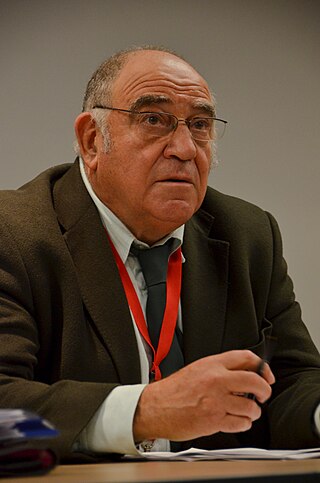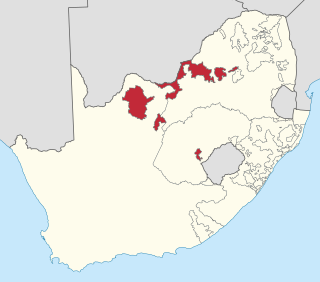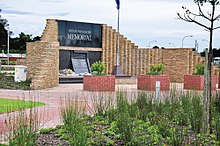
Bhisho, alternatively rendered Bisho, is the capital of the Eastern Cape province in South Africa. The Office of the Premier, Provincial Legislature and many other government departments are headquartered in the town. The town, three kilometres from Qonce and 70 kilometres from East London, is also part of Buffalo City.

Ciskei was a Bantustan for the Xhosa people-located in the southeast of South Africa. It covered an area of 7,700 square kilometres (3,000 sq mi), almost entirely surrounded by what was then the Cape Province, and possessed a small coastline along the shore of the Indian Ocean.
1994 in South Africa saw the transition from South Africa's National Party government who had ruled the country since 1948 and had advocated the apartheid system for most of its history, to the African National Congress (ANC) who had been outlawed in South Africa since the 1950s for its opposition to apartheid. The ANC won a majority in the first multiracial election held under universal suffrage. Previously, only white people were allowed to vote. There were some incidents of violence in the Bantustans leading up to the elections as some leaders of the Bantusans opposed participation in the elections, while other citizens wanted to vote and become part of South Africa. There were also bombings aimed at both the African National Congress and the National Party and politically-motivated murders of leaders of the opposing ANC and Inkatha Freedom Party (IFP).
1990 in South Africa saw the official start of the process of ending Apartheid. President of South Africa, eid. President De Klerk unbanned organisations that were banned by the government including the African National Congress, the South African Communist Party and the Pan Africanist Congress. The African National Congress, Umkhonto we Sizwe, suspends its armed activity within South Africa. Political prisoners including Nelson Mandela were released. Nelson Mandela met ANC leader Oliver Tambo for the first time in 28 years at a meeting in Sweden. Mandela also traveled to England to thank the people for their support in the campaign to free him. South Africa withdrew its troops from Namibia, which was granted independence. 1990 also saw marches in support and against the formation of a new post-Apartheid South Africa.
The following lists events that happened during 1992 in South Africa.
Joshua Oupa Gqozo was the military ruler of the former homeland of Ciskei in South Africa.

Ronald Kasrils is a South African politician, Marxist revolutionary, guerrilla and military commander. He was Minister for Intelligence Services from 27 April 2004 to 25 September 2008. He was a member of the National Executive Committee (NEC) of the African National Congress (ANC) from 1987 to 2007 as well as a member of the Central Committee of the South African Communist Party (SACP) from December 1986 to 2007.

The apartheid system in South Africa was ended through a series of bilateral and multi-party negotiations between 1990 and 1993. The negotiations culminated in the passage of a new interim Constitution in 1993, a precursor to the Constitution of 1996; and in South Africa's first non-racial elections in 1994, won by the African National Congress (ANC) liberation movement.

The 1994 Bophuthatswana crisis was a major political crisis which began after Lucas Mangope, the president of Bophuthatswana, a South African bantustan created under apartheid, attempted to crush widespread labour unrest and popular demonstrations demanding the incorporation of the territory into South Africa pending non-racial elections later that year. Violent protests immediately broke out following President Mangope's announcement on 7 March that Bophuthatswana would boycott the South African general elections. This was escalated by the arrival of right-wing Afrikaner militias seeking to preserve the Mangope government. The predominantly black Bophuthatswana Defence Force and police refused to cooperate with the white extremists and mutinied, they then forced the Afrikaner militias to leave Bophuthatswana.
The Boipatong massacre took place on the night of 17 June 1992 in the township of Boipatong, South Africa.

The Ciskei Defence Force (CDF) was established during March 1981 from the 141 Battalion of the South African Defence Force (SADF). It was the defence force of Ciskei, a bantustan that was controlled by the apartheid regime of South Africa. The CDF functioned as part of the 21 Battalion based near Lenasia, outside Johannesburg.
The Goldstone Commission, formally known as the Commission of Inquiry Regarding the Prevention of Public Violence and Intimidation, was appointed on 24 October 1991 to investigate political violence and intimidation in South Africa. Over its three-year lifespan, it investigated incidents occurring between July 1991 and April 1994, when democratic elections were held. The relevant incidents thus occurred during the negotiations to end apartheid. The Commission's mandate was both to investigate the causes of the violence and to recommend measures to contain or prevent it.
Boipatong Vanderbijlpark is a township in Gauteng, South Africa. It was established in 1955 to house black residents who worked in Vanderbijlpark and Vereeniging.

111 Battalion was a motorised infantry unit of the South African Army.

151 South African Infantry Battalion was a motorised infantry unit of the South African Army.

118 South African Infantry Battalion was a motorised infantry unit of the South African Army.

On 8 October 1993, Mzwandile Mfeya, Sandiso Yose, twins Samora and Sadat Mpendulo and Thando Mtembu were shot dead in a South African Defence Force (SADF) raid on an alleged base of the Azanian People's Liberation Army (APLA), the Pan Africanist Congress' military wing, at the Mpendulo family home in the Northcrest suburb of Mthatha. The house belonged to a PAC member Sicelo Mpendulo, the father of Samora and Sadat. According to PAC and police sources in the Transkei, the five victims were killed in their beds. The raid was authorised by President F. W. de Klerk.
Lt. General Xhanti Charles Sebe was leader of the Ciskei Defence Force- the military of the Bantustan of Ciskei, and its Director of State Security. A former Security Branch policeman, he later joined the South African Bureau of State Security (B.O.S.S.) before founding the Ciskei state security apparatus.

The 1990 Ciskei coup d'état was a bloodless military coup in Ciskei, an unrecognised state and a nominally independent South African homeland for the Xhosa people, which took place on 4 March 1990. The coup was led by the then 37-year-old Brigadier Oupa Gqozo, the Chief of Staff Intelligence of the Ciskei Defence Force, against the government of President for Life Lennox Sebe (CNIP), who was on a state visit to Hong Kong at the time. The coup was followed by widespread rioting and looting, prompting Gqozo to request that the South African government send SADF troops to help restore order.
The Ciskei National Independence Party (CNIP) was a political party in the nominally independent South African homeland of Ciskei. It was founded and led by Lennox Sebe. The party advocated cooperation with the South African government. The party governed Ciskei from 1973 until the 1990 coup d'état by Oupa Gqozo.












